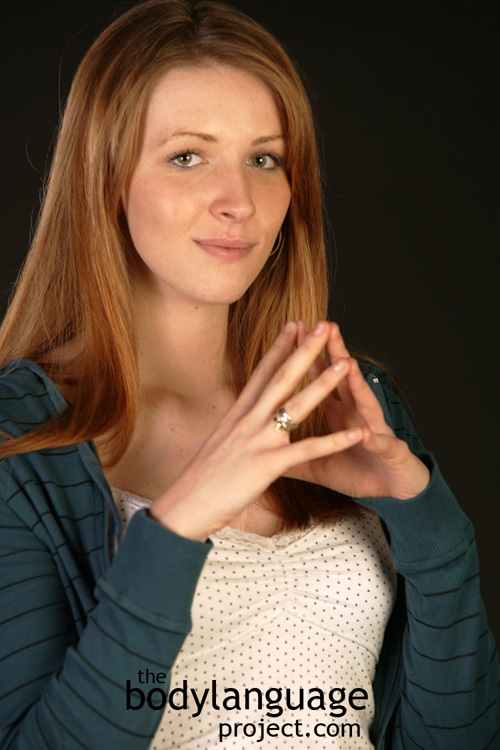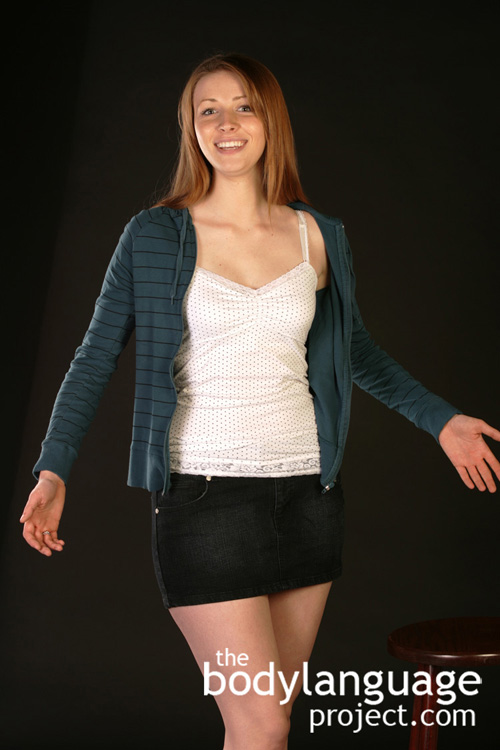The Hidden Body Language of Hand Steepling
 Cue: Hand Steepling.
Cue: Hand Steepling.
Synonym(s): Steepling The Hands, Tenting the Fingers, Finger Steepling, Hand Tenting.
Description: A posture where the hands are propped up by the fingers of each hand to form a bridge – like a church steeple. In this posture fingers are not interlocked and the palms do not touch. Instead, the finger tips simply touch at their tips.
In One Sentence: Hand steepling is a sign of confidence and that one knows something that another doesn’t.
How To Use it: Use hand steepling to demonstrate true or feigned confidence. This can work when portraying an image of strength is beneficial such as in business or legal negotiations. Steeple the hands when you want other people to think that you are privy to beneficial information that they are not.
Context: General.
Verbal Translation: “I have access to hidden information, and life experience, and this is the source of my power and control over you. I demonstrate this by pressing my fingertips together in a high confidence hand gesture like the roof of a church.”
Variant: Rocking might accompany the steeple where the hands move back and forth by adding and reducing pressure between them. The steeple can be placed low on a lap, or seen hovering slightly above the lap. Other times the steeple is in full view of others with the elbows propped up on the table. The steepler can hold the posture so high that they have to look through the steeple to see others. See Hand Clasping, Hand Wringing, Hand Clasping.
Cue In Action: Donald Trump performed the steeple frequently on his television show The Apprentice, in preparation, of all things, to fire his next apprentice! His steepling was an obvious cue signaling the power he had over his subordinates.
Meaning and/or Motivation: The steepler is someone that is confident, sometimes overconfident, authoritative, and particularly evaluative of others around him.
Confidence, in this case, is held in the power and control they possess and also in knowing things that other people do not. Steeplers are found carrying the gesture when around subordinates, or whenever they seem to have the upper hand. This gesture is effective if you already possess power or want others to think you do, but it is ineffective in team building, since it comes off as arrogant. It does have subconscious manipulative properties though, such as bluffing in poker but in most cases, this gesture is only as effective as that which can be backed up with real confidence and true access to valuable hidden information.
Superiors will also be seen using this gesture in meetings and when giving orders and the higher the steeple is held, the greater the arrogance it depicts. In extreme forms, the person carrying the gesture can be seen “looking right through their hands” between the triangle formed by the pent up fingers and the thumbs.
A high steepler comes off as a “know-it-all” and arrogant and smug especially when coupled with the head tilted backward. A more subtle version is the hidden steeple of which the sender could be trying to hide or shelter their opinion from view by keeping the steepled fingers below the table. The lower steeple is more often used by women and when someone is listening rather than speaking. A low steeple signifies that someone is interested and ready to respond.
Hidden steepling, such as a steeple on the lap under a table, refers to hidden confidence or a desire to limit arrogance in attempt to appear more open and accepting. When the hands are steepled, but holding support of the head, it does not signal confidence, but rather boredom, self-consciousness, or awkwardness.
Steepling can also ebb and flow along with confidence to what is being said which can be useful in negotiations or in arguments. If something is said to drop confidence the steepling might be broken in favour of interlocked hands as if praying but then quickly return when a person feels that their position has improved. Interlocked fingers is a signal of low confidence and the fingers might even be seen wringing themselves. Lawyers quickly learn to control this nonverbal cue in favour of constant steepling rather than any other gesture.
Cue Cluster: The steeple can occur in body language clusters as well, but what is important is not what happens after the steepling, as in the chin stroke and eye glass language, but rather what happens preceding the steepling. By watching for positive open postures such as palms up and arms un-crossed or closed postures such as arms crossed, touching the nose or face and avoiding eye contact, we can tell if the person is trying to be honest or manipulative with his or her apparent power. In other words, steepling is a finish posture serving to punctuate a body language clue cluster rather than the other way around.
Another example of a cue cluster is as follows: crossing the legs by bringing one foot over the opposite leg (the figure-four leg cross), fingers steepling, leaning back in the chair, and tilting the head back and looking down through the nose at others. This cluster shows arrogance and superiority.
Body Language Category: Arrogance or arrogant body language, Authoritative body language, Confident body language, Dominant body language, High confidence body language, High confidence hand displays, Leadership body language, Power play, Up nonverbals.
Resources:
Alibali, M.W., Heath, D.C., and Myers,H.J. (2001). Effects of visibility between speaker and listener on gesture production: Some gestures are meant to be seen. Journal of Memory and Language, 44, 169–188.
Andric, Michael ; Solodkin, Ana ; Buccino, Giovanni ; Goldin-Meadow, Susan ; Rizzolatti, Giacomo ; Small, Steven L. Brain function overlaps when people observe emblems, speech, and grasping. Neuropsychologia, 2013, Vol.51(8), pp.1619-1629
Adams, E.S., Mesterton-Gibbons, M., 1995. The cost of threat displays and the stability of deceptive communication. J. Theor. Biol. 175, 405–421.
Boyson, A. R., Pryor, B., & Butler, J. (1999). Height as power in women. North American Journal of Psychology, 1, 109–114.
Beattie, G., & Shovelton,H.(1999). Mapping the range of information contained in the iconich and gestures that accompany spontaneous speech. Journal of Language and social Psychology, 18, 438–462.
Biau, E., & Soto-Faraco, S.(2013). Beat gestures modulate auditory integration in speech perception. Brain and Language, 124(2), 143–152.
Beattie, G., & Shovelton,H.(1999). Mapping the range of information contained in the iconich and gestures that accompany spontaneous speech. Journal of Language and social Psychology, 18, 438–462.
Biau, E., & Soto-Faraco, S.(2013). Beat gestures modulate auditory integration in speech perception. Brain and Language, 124(2), 143–152.
Bartolo, A.,Cubelli,R.,DellaSala,S.,&Drei,S.(2003).Pantomimes are special gestures which rely on working memory. Brain and Cognition, 53, 483–494.
Bernardis, P.,& Gentilucci,M.(2006).Speech hand gestures are the same communication system. Neuropsychologia, 44, 178–190.
Buccino, G.,Vogt,S., Ritzl, A., Fink, G .R., Zilles, K., Freund, H. J., et al.(2004).Neural circuits underlying imitation learning of hand actions: Anevent-related fMRI study. Neuron, 42, 323–334.
Burgoon, J. K., Johnson, M. L., & Koch, P. T. (1998). The nature and measurement of interpersonal dominance. Communication Monographs, 65, 308–335.
Blum, Miriam D. (1988). The Silent Speech of Politicians (San Diego: Brenner Information Group).
Carney, D. R., Hall, J. A., & LeBeau, L. S. (2005). Beliefs about the nonverbal expression of social power. Journal of Nonverbal Behavior, 29, 105–123.
Chandler, Jesse ; Schwarz, Norbert. How extending your middle finger affects your perception of others: Learned movements influence concept accessibility. Journal of Experimental Social Psychology. 2009. 45(1): 123-128.
http://bodylanguageproject.com/articles/how-extending-the-middle-finger-affects-perception/
Dick, A.S., Goldin-Meadow,S., Hasson,U.,Skipper, J.I., & Small, S.L. (2009). Co- speech gestures influence neural activity in brain regions associated with processing semantic information. Human Brain Mapping, 30, 3509–3526.
Ellis, L. (1994). The high and the mighty among man and beast: How universal is the relationship between height (or body size) and social status? In L. Ellis (Ed.). Social stratification and socioeconomic inequality (Vol. 2, pp. 93–111). Westport, CT: Praeger Publishers.
Fabbri-Destro, M.,& Rizzolatti,G. (2008). Mirror neurons and mirror systems in monkeys and humans. Physiology, 23, 171–179.
Fogassi, L., Gallese,V., Fadiga,L., & Rizzolatti,G. (1998). Neurons responding to the sight of goal directed hand/armactions in the parietal area PF (7b) of the macaque monkey. Society for Neuroscience, 24, 257.5.
Fusaro, M., Harris, P. L., & Pan, B. A. (2012). Head nodding and head shaking gestures in children’s early communication. First Language, 32, 439–458. doi:10.1177/0142723711419326
Gentilucci, M., Bernardis, P., Crisi,G., & Dalla Volta, R. (2006). Repetitive transcranial magnetic stimulation of Broca’s area affects verbal responses to gesture observation. Journal of Cognitive Neuroscience, 18, 1059–1074.
Goldin-Meadow, S. (1999).The role of gesture in communication and thinking. Trends in Cognitive Sciences, 3, 419–429.
Goldin-Meadow, S.(2003). Hearing gesture: How our hands help us think. Cam-bridge, MA: Belknap Press of Harvard University Press.
Gräfenhain, M., Behne, T., Carpenter, M., & Tomasello, M. (2009). One-year-olds’ understanding of nonverbal gestures directed to a third person. Cognitive Development, 24, 23–33. doi:10.1016/j.cogdev.2008.10.001
Guidetti, M. (2005). Yes or no? How do young children combine gestures and words to agree and refuse. Journal of Child Language, 32, 911–924. doi:10.1017/S0305000905007038
Hass, Hans (1970). The Human Animal (New York: G.P. Putnam’s Sons).
Holle, H., & Gunter,T.C. (2007). The role of iconic gestures in speech disambiguation: ERP evidence. Journal of Cognitive Neuroscience, 19, 1175–1192.
Holler, J., Shovelton, H.,& Beattie, G.(2009).Do iconic hand gestures really contribute to the communication of semantic information in a face-to-face context? Journal of Nonverbal Behavior, 33, 73–88.
Hubbard, A.L., Wilson, S. M., Callan, D. E., & Dapretto, M.(2009).Giving speech a hand: Gesture modulates activity in auditory cortex during speech perception. Human Brain Mapping, 30, 1028–1037.
Hummer, P., Wimmer, H., & Antes, G. (1993). On the origins of denial negation. Journal of Child Language, 20, 607– 618. doi:10.1017/S0305000900008503
Hubbard, A.L., Wilson,S.M., Callan,D.E., & Dapretto, M.(2009). Giving speech a hand: Gesture modulates activity in auditory cortex during speech perception. Human Brain Mapping, 30, 1028–1037.
He, Yifei ; Gebhardt, Helge ; Steines, Miriam ; Sammer, Gebhard ; Kircher, Tilo ; Nagels, Arne ; Straube, Benjamin. The EEG and fMRI signatures of neural integration: An investigation of meaningful gestures and corresponding speech. Neuropsychologia. 2015. 72: 27-42.
Hansen, Jacqueline. Teaching without talking: teachers need to be aware of more than just the words they speak to children. They also need to monitor the nonverbal messages that they’re sending to students through proximity, eye contact, gestures, and touching. Phi Delta Kappan. 2010. 92(1): 35(6).
Holle, H., & Gunter,T.C. (2007). The role of iconic gestures in speech disambiguation: ERP evidence. Journal of Cognitive Neuroscience, 19, 1175–1192.
Holler, J., Shovelton, H.,& Beattie, G.(2009).Do iconic hand gestures really contribute to the communication of semantic information in a face-to-face context? Journal of Nonverbal Behavior, 33, 73–88.
Hubbard, A.L., Wilson, S. M., Callan, D. E., & Dapretto, M.(2009).Giving speech a hand: Gesture modulates activity in auditory cortex during speech perception. Human Brain Mapping, 30, 1028–1037.
Kelly, S. D., Barr, D. J., Church, R. B., & Lynch, K.(1999).Offering a hand topragmatic understanding: The role of speech and gesture in comprehension and memory. Journal of Memory and Language, 40, 577–592.
Kelly, S. D., Creigh, P., & Bartolotti, J.(2009).Integrating speech and iconic gestures in a Stroop-like task: Evidence for automatic processing. Journal of Cognitive Neuroscience, 22, 683–694.
Kelly, S.D., Kravitz, C.,& Hopkins, M.(2004).Neural correlates of bimodal speech and gesture comprehension. Brain and Language, 89(1), 253–260.
Krahmer,E., & Swerts, M.(2007).The effects of visual beats on prosodic prominence: Acoustic analyses, auditory perception and visual perception. Journal of Memory and Language, 57, 396–414.
Krauss, R. M., Dushay, R.A., Chen,Y., & Rauscher, F.(1995).The communicative value of conversational hand gesture. Journal of Experimental Social Psychology, 31(6), 533–552.
Kendon,A.(1994).Do gestures communicate? A review. Research on Language and Social Interaction, 27, 175–200.
Knutson, K.M., McClellan,E.M., & Grafman, J.(2008).Observing social gestures: An fMRI study. Experimental Brain Research, 188, 187–198.
Kelly, S. D., Barr, D. J., Church, R. B., & Lynch, K.(1999).Offering a hand topragmatic understanding: The role of speech and gesture in comprehension and memory. Journal of Memory and Language, 40, 577–592.
Kelly, S. D., Creigh, P., & Bartolotti, J.(2009).Integrating speech and iconic gestures in a Stroop-like task: Evidence for automatic processing. Journal of Cognitive Neuroscience, 22, 683–694.
Kelly, S.D., Kravitz, C.,& Hopkins, M.(2004).Neural correlates of bimodal speech and gesture comprehension. Brain and Language, 89(1), 253–260.
Krahmer,E., & Swerts, M.(2007).The effects of visual beats on prosodic prominence: Acoustic analyses, auditory perception and visual perception. Journal of Memory and Language, 57, 396–414.
Krauss, R. M., Dushay, R.A., Chen,Y., & Rauscher, F.(1995).The communicative value of conversational hand gesture. Journal of Experimental Social Psychology, 31(6), 533–552.
Leonard, T., & Cummins, F.(2010).The temporal relation between beat gestures and speech. Language and Cognitive Processes, 26, 1457–1471.
Leonard, T., & Cummins, F.(2010).The temporal relation between beat gestures and speech. Language and Cognitive Processes, 26, 1457–1471.
Lindenberg, R., Uhlig,M., Scherfeld,D., Schlaug,G., & Seitz, R.J.(2012).Commu- nication with emblematic gestures: Shared and distinct neural correlates of expression and reception. Human Brain Mapping, 33, 812–823.
Morris, Desmond (1994). Bodytalk: The Meaning of Human Gestures (New York: Crown Publishers).
Montgomery, K.J., Isenberg, N., & Haxby,J.V. (2007). Communicative hand gestures and object-directed hand movements activated the mirror neuron system. Social Cognitive and Affective Neuroscience, 2, 114–122.
Molnar-Szakacs, Istvan ; Wu, Allan D ; Robles, Francisco J ; Iacoboni, Marco Robertson, Edwin (Academic Editor). Do You See What I Mean? Corticospinal Excitability During Observation of Culture-Specific Gestures (Gesture Perception). PLoS ONE. 2007. 2(7): p.e626
Meier, B. P., Hauser, D. J., Robinson, M. D., Friesen, C. K., & Schjeldahl, K. (2007b). What’s ‘up’ with God?: Vertical space as a representation of the divine. Journal of Personality and Social Psychology, 93, 699–710.
Meier, B. P., & Robinson, M. D. (2004). Why the sunny side is up: Associations between affect and vertical position. Psychological Science, 15, 243–247.
Meier, B. P., & Robinson, M. D. (2005). The metaphorical representation of affect. Metaphor and Symbol, 21, 239–257.
Melamed, T. (1992). Personality correlates of physical height. Personality and Individual Differences, 13, 1349–1350.
Middleton, W. C., &Moffett, D. C. (1940). The relation of height and weight measurements to intelligence and to dominance-submission among a group of college freshmen. Research Quarterly of the American Association for Health, Physical Education, and Recreation, 11, 53–59.
Montepare, J. M. (1995). The impact of variations in height on young children’s impressions of men and women. Journal of Nonverbal Behavior, 19, 31–47.
Meier, B.P., Robinson, M.D., & Caven, A.J. (in press). Why a big mac is a good mac: Associations between affect and size. Basic and Applied Social Psychology.
Matsumura, Shuichi ; Hayden, Thomas J. When should signals of submission be given?–A game theory model. Journal of Theoretical Biology. 2006. 240(3): 425-433.
Navarro, Joe. 2008. What Every BODY is Saying: An Ex-FBI Agent’s Guide to Speed-Reading People. William Morrow Paperbacks.
Navarro, Joe. A four-domain model for detecting deception: an alternative paradigm for interviewing. The FBI Law Enforcement Bulletin. 2003. 72(6): 19(6).
Navarro, Joe. A four-domain model for detecting deception: an alternative paradigm for interviewing. The FBI Law Enforcement Bulletin. 2003. 72(6): 19(6).
Ohgami, Y., Matsuo,K., Uchida,N., & Nakai,T. (2004). An fMRI study of tool-use gestures: Body partas object and pantomime. Neuroreport, 15, 1903–1906.
Pease, Barbara and Allan Pease. 2006. The Definitive Book of Body Language Hardcover. Bantam.
Prieto, A. G., & Robbins, M. C. (1975). Perceptions of height and self-esteem. Perceptual and Motor Skills, 40, 395–398.
Robinson, Michael D. ; Zabelina, Darya L. ; Ode, Scott ; Moeller, Sara K. The vertical nature of dominance-submission: Individual differences in vertical attention. Journal of Research in Personality. 2008. 42(4): 933-948.
Schubert, T. W. (2005). Your highness: Vertical positions as perceptual symbols of power. Journal of Personality and Social Psychology, 89, 1–21.
Schwartz, B., Tesser, A., & Powell, E. (1982). Dominance cues in nonverbal behavior. Social Psychology Quarterly, 45, 114–120.
Stepper, S., & Strack, F. (1993). Proprioceptive determinants of emotional and nonemotional feelings. Journal of Personality and Social Psychology, 64, 211–220.
Schenkel, Rudolf. Submission: Its Features and Function in the Wolf and Dog. American Zoologist. 1967. 7(2): 319-329.
Tiedens, Larissa Z ; Fragale, Alison R. Power moves: complementarity in dominant and submissive nonverbal behavior. Journal of personality and social psychology. 2003. 84(3): 558-68.
Tracy, J. L., & Robins, R. W. (2004). Show your pride: Evidence for a discrete emotion expression. Psychological Science, 15, 194–197.
Skipper, J.I., Goldin-Meadow, S., Nusbaum,H.C.,& Small,S.L. (2007).Speech- associated gestures, Broca’s area, and the human mirror system. Brain and Language, 101, 260–277.
Sherzer, Joel The Brazilian Thumbs-Up Gesture. Journal of Linguistic Anthropology, 1991, Vol.1(2), pp.189-197
Straube,B., Green,A., Bromberger,B., & Kircher, T. (2011).The differentiation of iconic and metaphoric gestures: Common and unique integration processes. Human Brain Mapping, 32, 520–533.
Straube, Benjamin ; Green, Antonia ; Jansen, Andreas ; Chatterjee, Anjan ; Kircher, Tilo. Social cues, mentalizing and the neural processing of speech accompanied by gestures. Neuropsychologia. 2010. 48(2): 382-393.
Tam, C. W., & Stokes, S. F. (2001). Form and function of negation in early developmental Cantonese. Journal of Child Language, 28, 373–391. doi:10.1017/S0305000901004688
Villarreal, M., Fridman,E.A., Amengual,A., Falasco,G., Gerscovich,E.R., Ulloa,E.R., et al. (2008). The neural substrate of gesture recognition. Neuropsychologia, 46, 2371–2382.
Vaidyanathan, R. (1991). Development of forms and functions of negation in the early. tages of language acquisition: A study in Tamil. Journal of Child Language, 18, 51–66. doi:10.1017/S0305000900013295
Willems, R.M., Ozyurek,A., & Hagoort,P.(2007).When language meets action:The neural integration of gesture and speech. CerebralCortex, 17, 2322–2333.
Wieser, Matthias J.; Tobias Flaisch and Paul Pauli. Raised Middle-Finger: Electrocortical Correlates of Social Conditioning with Nonverbal Affective Gestures. 2014. PLoS ONE 9(7): e102937. doi:10.1371/journal.pone.0102937
http://bodylanguageproject.com/articles/powerful-nonverbal-effect-raised-middle-finger-persistent-brain-consequences-pairing/
Wu, Y. C., & Coulson, S.(2005).Meaningful gestures: Electrophysiological indices of iconic gesture comprehension. Psychophysiology, 42, 654–667.
Wang, Lin ; Chu, Mingyuan Neuropsychologia. The role of beat gesture and pitch accent in semantic processing: An ERP study. 2013, Vol.51(13), pp.2847-2855
Xu,J., Gannon,P.J., Emmorey,K., Smith,J.F., & Braun,A.(2009). Symbolic gestures and spoken language are processed by a common neural system. Proceedings of the NationalAcademyofSciences, 106, 20664–20669.
Wang, Lin ; Chu, Mingyuan Neuropsychologia. The role of beat gesture and pitch accent in semantic processing: An ERP study. 2013, Vol.51(13), pp.2847-2855.
 Cue: Wrist Hold Handshake and Upper Arm Grip Handshake
Cue: Wrist Hold Handshake and Upper Arm Grip Handshake




